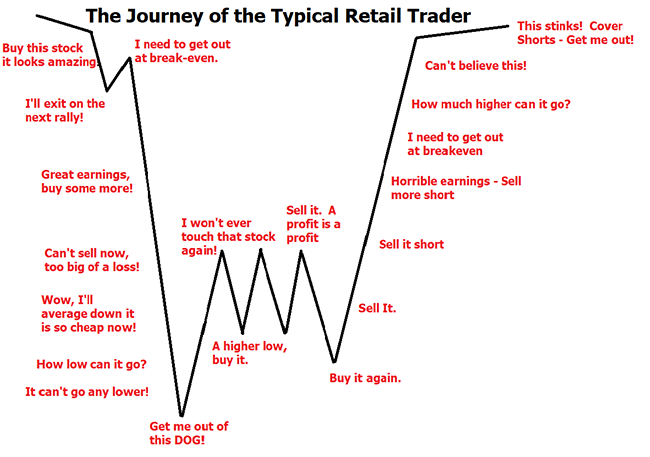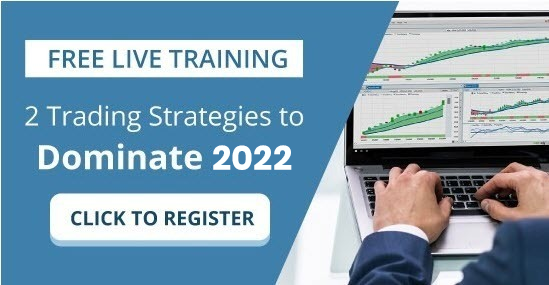
Whenever difficult times arise, like the current market environment, one of the most helpful things that a trader can do is to assess their personal inventory and evaluate the correct and incorrect things that they did in their trading portfolio.
I have long claimed the most empowering question a trader should focus on is, “what is the worst trade you ever made?”
The purpose of that question is to discover what you learned from that painful experience. The losing side of the ledger is always the most profitable side of the ledger.
Most traders do not have the psychological fortitude to analyze and truly understand their losses. In Capitalism, learning what does not work is the fuel that allows an economy to grow. Likewise, in trading, if we are to be successful, we need to thoroughly understand what is ineffective.
We all have bad experiences in life. But what if we could learn something from them? What if, instead of dwelling on the pain and hurt, we could view bad experiences as opportunities for growth?
When we go through tough times, we have the chance to learn and grow. We can develop wisdom and knowledge that we can use in future situations. We can learn to be more resilient and to see the silver lining in every cloud.
So next time you have a bad trade, remember that it is an opportunity to learn and to grow. Embrace the challenge and use it to become a better version of yourself. While bad trades are often painful, they can also be invaluable learning opportunities. Wisdom gained from bad trades can help us to avoid making the same mistakes in the future.
Knowledge gleaned from bad experiences can also help us to better understand and empathize with others who are going through similar situations. In short, bad experiences can teach us a great deal about ourselves and the world around us. While it is natural to wish to avoid pain, it is important to remember that bad experiences are an opportunity for growth. By approaching them with openness and curiosity, we can often find hidden gifts that we would have otherwise missed.
If I were to summarize the psychology of losing traders, it would always revolve around the fear of losing money. Concisely stated, the problem most losing traders have is they take large losses and very small profits. This simple process is a recipe for disaster. However, when you dissect the problem into its smaller components it is easily correctable.
Our mind views a loss as painful and tragic. It is an admission that we are wrong. We don’t like to lose what we have. Therefore, when we have a losing trade, it is quite common to avoid realizing the loss. By refusing to cut our losses, we open ourselves up to even bigger losses. Traders refer to this as praying to the price and trading on hope.
Let me share a few anecdotes from my interaction with students and friends. One very good friend of mine loved to trade Pork Bellies, Coffee, and Cocoa. We were talking on the phone one day and I challenged him to look at his stats. I simply asked him to look at all of his trades over the past year and discover what was his best market to trade and what were his worst markets to trade. To his amazement, his three worst markets were Coffee, Cocoa, and Pork Bellies. Once he stopped trading them, his trading account began to grow exponentially.
I highly recommend that you examine your own portfolio and discover what are your best markets to trade and what are your worst. The sign of a mature, confident trader is knowing with certainty what they are good at and what they are bad at.
Another student of mine, traded forex full time. When he evaluated everything, he traded over the period of one year, he discovered that all of his profits came from trading the Euro versus U.S. Dollar and the British Pound versus the U.S. Dollar. Today those are the only two markets that he focuses on. He has learned, it is wiser to ignore everything else.
Great traders know their metrics. They are primarily focused on how often and how much they win; against how often and how much they lose.
This simple guideline provides an expectancy to their trading. They arrived at this expectancy by constantly studying their batting average and the markets they trade. They are always working to improve their statistical expectancy by taking smaller losses.
Trading should not be an adrenalin or serotonin rush.
Great trading is as boring as watching paint dry.
You find a great trend.
Before you get in you decide what your risk is.
You place your trade, and you accept the outcomes.
Over the years, I have worked with a lot of traders. The one barrier they need to overcome to succeed is learning how to take a loss. Have you ever watched a football game where the quarterback fumbles the snap from the center at the beginning of a play? My experience has been that a bad quarterback tries to salvage the play and the majority of the time ends up making things much worse. When this same experience occurs to a great quarterback, they simply fall on the ball and take the loss.
On occasion there are exceptions, but over the long haul you will notice that great players and coaches place an extremely high focus on DEFENSE. A great defensive game focuses on survival first and foremost.
Newcomers to the trading world are very enthusiastic about growing their accounts. They think they can find the next Amazon or Google.
They are usually highly leveraged and live for the thrill of going all in.
They are often cocky, arrogant, and focused on their offensive game. These types of traders get wrecked whenever we see a small downturn in the markets. Concisely, their Achilles heel is that they don’t know how to take a loss. Some of it might be ego or pride. Usually, they must destroy their trading account before they recognize the error of their ways.
One of the most powerful lessons I ever learned in trading was how to trade small. A mentor said that he wanted to see my metrics every ten trades. He warned that unless I reduced my trade size 90%, I might not be around in ten trades.
While that comment hurt my ego, it taught me the guiding principle of long-term survival and a method for developing objective consistency in my trading.
Anyone who has ever tried to trade in the financial markets knows that it is a risky business. Even the most experienced traders can lose money, and for new traders, the risks can be even greater. One of the best ways to reduce these risks is to learn how to trade small. By trading small, you learn to take losses without damaging your account. You also learn to eliminate fear and greed from your trading decisions. Remaining objective is essential in trading, and by trading small, you can stay focused on your goals without being swayed by emotions. Finally, trading small allows you to trade with the trend, which is one of the most important factors in successful trading. By learning how to trade small, trading is not a life-and-death struggle.
In the past few months, we have seen huge meltdowns in the markets.
Netflix, Facebook, and Amazon all had huge overnight down moves. If you were trading small, even if you were on the wrong side of those trends, you survived. If you were trading large and you were on the wrong side of those down moves your account was destroyed.
Great trading is never about how much you make when you are right. It is always about how little you lose when you are wrong. Stick around long enough in the trading world and you will come to appreciate very quickly that markets are humbling mechanisms.
Show me a great trader and I will guarantee that what makes them great is their ability to trade small and take losses. Today, I regularly monitor my metrics but because of my focus on trading small, I know that I am going to be around 10,000 trades from now and still improving my game.
Here is a graphic I created to illustrate the way that a typical retail trader trades.

The typical trader is trapped in their own experience and is constantly telling themselves a story. One of my most important lessons in trading was that in my early years I loved to tell the market that it was wrong. This led me to practice revenge trading just to strike back at the demon who had stolen my money.
It is a common malady.
It took me a long time to realize that I was addicted to the storytelling drama of trading. The battle never ends as I worked to be the knight in shining armor.
Once I learned that I was trading too large and too often, my results completely turned around.
As I mentioned earlier, great trading is often like watching paint dry.
It involves finding a great trend and deciding how much you are willing to risk, and simply surrendering to it.
In the current market environment, do you know what is working and who is winning? In other words, where is the money being made?
Hint: Until you answer that question you do not have the odds in your favor. The simplest thing in the world is to surrender to strong trends that are working.
What immature traders often do is they think they know more than the market and use selective reasoning to choose what and how trade. Often, they are fighting the trend and living for the next adrenalin rush.
Answer the question of where the money is being made and align yourself with that trend and your trading success is all but assured.
But recognize that the answer to this question changes regularly.
Bad traders accept small profits and large losses. They see trading as a game where they always need to be right to make money. This kind of thinking leads them to take unnecessary risks and to stay in losing trades too long, hoping that the market will turn around. Bad traders also tend to have a problem with over-trading, which means that they take too many trades and don’t give their winners enough room to run.
Bad trading is characterized by impulsive decision-making and a belief that you always have to be in the market.
I always tell other traders that if trading is really, really hard, you’re not doing it right.
Do you remember the Rubik’s Cube?
Did you have a Rubik’s cube growing up (or maybe even now)? That frustrating gizmo is the bestselling toy of all time, they’ve sold over 370 million units over the last 40 years.
Remember when you got it, each face of the classic square was covered by nine stickers of one color: white, red, blue, orange, green and yellow. And then you twisted it… The cube has that internal pivot mechanism which allowed the sides to be turned independently which would mix up all of the colors on all sides of the cube.
The challenge was to get that Rubik’s cube back to its uniformly color balanced cube in as little time as possible. It looks so easy, right? After all, how hard can it be to match the colors together?
If you have ever played with the Rubik’s cube, you’ll agree that it is highly addicting.
Let me go SUPERNERD on you for a minute: the cube has a total of 43,252,003,274,489,856,000 possible combinations.
Let me put it a different way because you’ve probably never confronted anything that massive; in everyday English that’s said like this:
43 quintillion, 252 quadrillion, 3 trillion, 274 billion, 489 million, 856 thousand.
Whew!
If you’ve never solved the Rubik’s cube, trust me you have a lot of company. That’s part of its allure and what makes it so addicting. It’s a badge of honor to solve it!
Most of us took a year to figure it out…if we ever did! There are a lot of cubes out there gathering dust that have never been “solved.” When the cube became all the rage in 1980, three of the top best-selling books in America were about learning to solve the Rubik’s cube.
We, humans, are changing though; today, someone is considered a top Rubiker if they can solve the puzzle in under 5 minutes.
Isn’t that amazing?
Let’s refer to this as the parable of the Rubik’s Cube. If it’s really, really difficult, you’re not doing it right.
At Vantagepoint, we live in the world of artificial intelligence (AI) to help traders. What I am about to tell you will change the way you look at artificial intelligence and machine learning forever.
An AI robot solved the Rubik’s cube in .637 seconds. That is a little over six-tenths of a second.
Growing up we spent weeks and weeks playing with the Rubik’s cube. Kids today have it a little easier – there’s a YouTube video that shows how to solve the Rubik’s cube. With practice you might be able to get under five minutes. But we humans will never beat machine learning.
So how do the AI machines do it? In a nutshell, the algorithm looks at the puzzle and can compute the most efficient way to solve the problem. With no emotion or frustration, the machines learn what doesn’t work, remember it, and focus on other possibilities.
Now take a moment to consider how machine learning can improve your investment/trading portfolio? That’s what Vantagepoint Software does! And it compiles more data than a single human (or even a 52-story high rise stuffed with analysts) can analyze to predict trends up to 3 days before they move with up to 87.4% proven accuracy. And they are still learning!
How have you done in your trading so far in 2022?
Do you have the tools to find the best high probability trades?
The purpose of artificial intelligence is to keep traders on the right side of the right trend at the right time. That is what makes it so valuable.
In the current environment only 27% of all stocks are trading above their 200 day moving averages.
Artificial intelligence has beaten humans at Chess, Checkers, Poker, Jeopardy and Go!
Why should trading be any different?
What artificial intelligence brings to the table is the ability to keep you on the right side, of the right trend at the right time. In today’s volatile world that is a very valuable proposition.
Artificial intelligence is so powerful because it learns what doesn’t work, remembers it, and then focuses on other paths to find a solution. This is the Feedback Loop that is responsible for building the fortunes of every successful trader I know.
If you think about this question, you will begin to appreciate that A.I. applies mistake prevention to discover what is true and workable. Artificial Intelligence applies mistake prevention as a continual process 24 hours a day, 365 days a year towards whatever problem it is looking to solve.
That should get you excited because it is a game-changer.
It sounds very elementary and obvious. But overlooking the obvious things often hurts a traders’ portfolio.
The basics are regularly overlooked by inexperienced traders.
The beauty of neural networks, artificial intelligence, and machine learning is that it is fundamentally focused on pattern recognition to determine the best move forward. When these technologies flash a change in forecast it is newsworthy. We often do not understand why something is occurring but that does not mean that we cannot take advantage of it.
A.I., through advanced pattern recognition, analyzing hundreds of thousands of data points, and crunching millions of computations, finds the highest probability trades and is indispensable in separating fact from fiction.
Intrigued? Visit with us and check out the A.I. at our Next Live Training.
It’s not magic. It’s machine learning.
Make it count.
IMPORTANT NOTICE!
THERE IS SUBSTANTIAL RISK OF LOSS ASSOCIATED WITH TRADING. ONLY RISK CAPITAL SHOULD BE USED TO TRADE. TRADING STOCKS, FUTURES, OPTIONS, FOREX, AND ETFs IS NOT SUITABLE FOR EVERYONE.
DISCLAIMER: STOCKS, FUTURES, OPTIONS, ETFs AND CURRENCY TRADING ALL HAVE LARGE POTENTIAL REWARDS, BUT THEY ALSO HAVE LARGE POTENTIAL RISK. YOU MUST BE AWARE OF THE RISKS AND BE WILLING TO ACCEPT THEM IN ORDER TO INVEST IN THESE MARKETS. DON’T TRADE WITH MONEY YOU CAN’T AFFORD TO LOSE. THIS ARTICLE AND WEBSITE IS NEITHER A SOLICITATION NOR AN OFFER TO BUY/SELL FUTURES, OPTIONS, STOCKS, OR CURRENCIES. NO REPRESENTATION IS BEING MADE THAT ANY ACCOUNT WILL OR IS LIKELY TO ACHIEVE PROFITS OR LOSSES SIMILAR TO THOSE DISCUSSED ON THIS ARTICLE OR WEBSITE. THE PAST PERFORMANCE OF ANY TRADING SYSTEM OR METHODOLOGY IS NOT NECESSARILY INDICATIVE OF FUTURE RESULTS. CFTC RULE 4.41 – HYPOTHETICAL OR SIMULATED PERFORMANCE RESULTS HAVE CERTAIN LIMITATIONS. UNLIKE AN ACTUAL PERFORMANCE RECORD, SIMULATED RESULTS DO NOT REPRESENT ACTUAL TRADING. ALSO, SINCE THE TRADES HAVE NOT BEEN EXECUTED, THE RESULTS MAY HAVE UNDER-OR-OVER COMPENSATED FOR THE IMPACT, IF ANY, OF CERTAIN MARKET FACTORS, SUCH AS LACK OF LIQUIDITY. SIMULATED TRADING PROGRAMS IN GENERAL ARE ALSO SUBJECT TO THE FACT THAT THEY ARE DESIGNED WITH THE BENEFIT OF HINDSIGHT. NO REPRESENTATION IS BEING MADE THAT ANY ACCOUNT WILL OR IS LIKELY TO ACHIEVE PROFIT OR LOSSES SIMILAR TO THOSE SHOWN.




